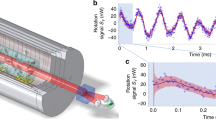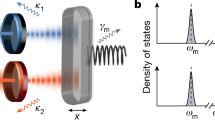Abstract
Entanglement-based technologies, such as quantum information processing, quantum simulations and quantum-enhanced metrology, have the potential to revolutionize our way of computing and measuring, and help clarify the puzzling concept of entanglement itself. Ultracold atoms on atom chips are attractive for their implementation, as they provide control over quantum systems in compact, robust and scalable set-ups. An important tool in this system is a potential depending on the internal atomic state. Coherent dynamics in such a potential combined with collisional interactions enables entanglement generation both for individual atoms and ensembles. Here, we demonstrate coherent manipulation of Bose-condensed atoms in a state-dependent potential, generated with microwave near-fields on an atom chip. We reversibly entangle atomic internal and motional states, realizing a trapped-atom interferometer with internal-state labelling. Our system provides control over collisions in mesoscopic condensates, paving the way to on-chip generation of many-particle entanglement and quantum-enhanced metrology with spin-squeezed states.
This is a preview of subscription content, access via your institution
Access options
Subscribe to this journal
Receive 12 print issues and online access
$209.00 per year
only $17.42 per issue
Buy this article
- Purchase on Springer Link
- Instant access to full article PDF
Prices may be subject to local taxes which are calculated during checkout





Similar content being viewed by others
References
DiVincenzo, D. The physical implementation of quantum computation. Fortschr. Phys. 48, 771–783 (2000).
Nielsen, M. A. & Chuang, I. L. Quantum Computation And Quantum Information (Cambridge Univ. Press, 2000).
Lloyd, S. Universal quantum simulators. Science 273, 1073–1078 (1996).
Jané, E., Vidal, G., Dür, W., Zoller, P. & Cirac, J. I. Simulation of quantum dynamics with quantum optical systems. Quant. Inf. Comput. 3, 15–37 (2003).
Dunningham, J. A. Using quantum theory to improve measurement precision. Contemp. Phys. 47, 257–267 (2006).
Childs, A. M., Preskill, J. & Renes, J. Quantum information and precision measurement. J. Mod. Opt. 47, 155–176 (2000).
Chu, S. Cold atoms and quantum control. Nature 416, 206–210 (2002).
Fortágh, J. & Zimmermann, C. Magnetic microtraps for ultracold atoms. Rev. Mod. Phys. 79, 235–289 (2007).
Du, S. et al. Atom-chip Bose–Einstein condensation in a portable vacuum cell. Phys. Rev. A 70, 053606 (2004).
Vogel, A. et al. Bose–Einstein condensates in microgravity. Appl. Phys. B 84, 663–671 (2006).
Whitlock, S., Gerritsma, R., Fernholz, T. & Spreeuw, R. J. C. Two-dimensional array of microtraps with atomic shift register on a chip. New J. Phys. 11, 023021 (2009).
Treutlein, P., Hommelhoff, P., Steinmetz, T., Hänsch, T. W. & Reichel, J. Coherence in microchip traps. Phys. Rev. Lett. 92, 203005 (2004).
Wang, Y.-J. et al. Atom Michelson interferometer on a chip using a Bose–Einstein condensate. Phys. Rev. Lett. 94, 090405 (2005).
Schumm, T. et al. Matter-wave interferometry in a double well on an atom chip. Nature Phys. 1, 57–62 (2005).
Günther, A. et al. Diffraction of a Bose–Einstein condensate from a magnetic lattice on a micro chip. Phys. Rev. Lett. 95, 170405 (2005).
Günther, A. et al. Atom interferometer based on phase coherent splitting of Bose–Einstein condensates with an integrated magnetic grating. Phys. Rev. Lett. 98, 140403 (2007).
Jo, G.-B. et al. Long phase coherence time and number squeezing of two Bose–Einstein condensates on an atom chip. Phys. Rev. A 98, 030407 (2007).
Jo, G.-B. et al. Phase-sensitive recombination of two Bose–Einstein condensates on an atom chip. Phys. Rev. Lett. 98, 180401 (2007).
Calarco, T. et al. Quantum gates with neutral atoms: Controlling collisional interactions in time-dependent traps. Phys. Rev. A 61, 022304 (2000).
Treutlein, P. et al. Microwave potentials and optimal control for robust quantum gates on an atom chip. Phys. Rev. A 74, 022312 (2006).
Li, Y., Treutlein, P., Reichel, J. & Sinatra, A. Spin squeezing in a bimodal condensate: Spatial dynamics and particle losses. Eur. Phys. J. B 68, 365–381 (2009).
Marte, A. et al. Feshbach resonances in rubidium 87: Precision measurement and analysis. Phys. Rev. Lett. 89, 283202 (2002).
Jaksch, D., Briegel, H.-J., Cirac, J. I., Gardiner, C. W. & Zoller, P. Entanglement of atoms via cold controlled collisions. Phys. Rev. Lett. 82, 1975–1978 (1999).
Mandel, O. et al. Controlled collisions for multiparticle entanglement of optically trapped atoms. Nature 425, 937–940 (2003).
Diener, R. B., Wu, B., Raizen, M. G. & Niu, Q. Quantum tweezer for atoms. Phys. Rev. Lett. 89, 070401 (2002).
Mohring, B. et al. Extracting atoms on demand with lasers. Phys. Rev. A 71, 053601 (2005).
Colombe, Y. et al. Strong atom-field coupling for Bose–Einstein condensates in an optical cavity on a chip. Nature 450, 272–276 (2007).
Dudarev, A. M., Raizen, M. G. & Niu, Q. Quantum many-body culling: Production of a definite number of ground-state atoms in a Bose–Einstein condensate. Phys. Rev. Lett. 98, 063001 (2007).
Widera, A. et al. Quantum spin dynamics of mode-squeezed Luttinger liquids in two-component atomic gases. Phys. Rev. Lett. 100, 140401 (2008).
Agosta, C. C., Silvera, I. F., Stoof, H. T. C. & Verhaar, B. J. Trapping of neutral atoms with resonant microwave radiation. Phys. Rev. Lett. 62, 2361–2364 (1989).
Spreeuw, R. J. C. et al. Demonstration of neutral atom trapping with microwaves. Phys. Rev. Lett. 72, 3162–3165 (1994).
Hofferberth, S., Lesanovsky, I., Fischer, B., Verdu, J. & Schmiedmayer, J. Radiofrequency-dressed-state potentials for neutral atoms. Nature Phys. 2, 710–716 (2006).
Bloch, I. Ultracold quantum gases in optical lattices. Nature Phys. 1, 23–30 (2005).
Treutlein, P. Coherent Manipulation of Ultracold Atoms on Atom Chips. PhD thesis, Ludwig–Maximilians-Universität München and Max-Planck-Institut für Quantenoptik (2008).
Collin, R. E. Foundations For Microwave Engineering 2nd edn (Wiley, 2001).
Ketterle, W., Durfee, D. S. & Stamper-Kurn, D. M. in Bose–Einstein Condensation In Atomic Gases, Proceedings Of The International School of Physics Enrico Fermi, Course CXL (eds Inguscio, M., Stringari, S. & Wieman, C. E.) 67–176 (IOS Press, 1999).
Matthews, M. R. et al. Dynamical response of a Bose–Einstein condensate to a discontinuous change in internal state. Phys. Rev. Lett. 81, 243–247 (1998).
Mateo, A. M. & Delgado, V. Ground-state properties of trapped Bose–Einstein condensates: Extension of the Thomas–Fermi approximation. Phys. Rev. A 75, 063610 (2007).
Sørensen, A., Duan, L.-M., Cirac, J. I. & Zoller, P. Many-particle entanglement with Bose–Einstein condensates. Nature 409, 63–66 (2001).
Micheli, A., Jaksch, D., Cirac, J. I. & Zoller, P. Many-particle entanglement in two-component Bose–Einstein condensates. Phys. Rev. A 67, 013607 (2003).
Bordé, C. J. Atomic interferometry with internal state labelling. Phys. Lett. A 140, 10–12 (1989).
Berman, P. R. (ed.) Atom Interferometry (Academic, 1997).
Scott, R. G., Judd, T. E. & Fromhold, T. M. Exploiting soliton decay and phase fluctuations in atom chip interferometry of Bose–Einstein condensates. Phys. Rev. Lett. 100, 100402 (2008).
Rosenbusch, P. Magnetically trapped atoms for compact atomic clocks. Appl. Phys. B 95, 227–235 (2009).
Hänsel, W., Hommelhoff, P., Hänsch, T. W. & Reichel, J. Bose–Einstein condensation on a microelectronic chip. Nature 413, 498–501 (2001).
Reinaudi, G., Lahaye, T., Wang, Z. & Guéry-Odelin, D. Strong saturation absorption imaging of dense clouds of ultracold atoms. Opt. Lett. 32, 3143–3145 (2007).
Ghione, G. & Naldi, C. Coplanar waveguides for MMIC applications: Effect of upper shielding, conductor backing, finite-extent ground planes, and line-to-line coupling. IEEE Trans. Microw. Theory Tech. 35, 260–267 (1987).
Acknowledgements
We are grateful to J. P. Kotthaus and his group for cleanroom access and advice on chip fabrication; F. Peretti, G. Csaba, F. J. Schmückle and F. Reinhardt for microwave simulations and helpful discussions on microwave design; and A. Sinatra and Y. Li for helpful discussions on spin squeezing. We thank S. Camerer, D. Hunger and A. Sinatra for careful reading of the manuscript. We acknowledge support of the Nanosystems Initiative Munich.
Author information
Authors and Affiliations
Contributions
P.T. and J.R. conceived the experiment. P.T. worked out the theory. P.B., M.F.R., J.H. and P.T. designed and built the experiment. P.B., M.F.R. and P.T. collected and analysed the data and wrote the manuscript. P.T. and T.W.H. supervised the experiment. All authors discussed the results and commented on the manuscript.
Corresponding author
Supplementary information
Supplementary Information
Supplementary Information (PDF 630 kb)
Rights and permissions
About this article
Cite this article
Böhi, P., Riedel, M., Hoffrogge, J. et al. Coherent manipulation of Bose–Einstein condensates with state-dependent microwave potentials on an atom chip. Nature Phys 5, 592–597 (2009). https://doi.org/10.1038/nphys1329
Received:
Accepted:
Published:
Issue Date:
DOI: https://doi.org/10.1038/nphys1329
This article is cited by
-
Classical analog of qubit logic based on a magnon Bose–Einstein condensate
Communications Physics (2022)
-
Error suppression in adiabatic quantum computing with qubit ensembles
npj Quantum Information (2021)
-
Dressed state dynamics of two-component Bose-Einstein Condensates in state-dependent potentials
Scientific Reports (2018)
-
Universal quantum gates for hybrid system assisted by atomic ensembles embedded in double-sided optical cavities
Scientific Reports (2017)
-
A minimalistic and optimized conveyor belt for neutral atoms
Scientific Reports (2017)



